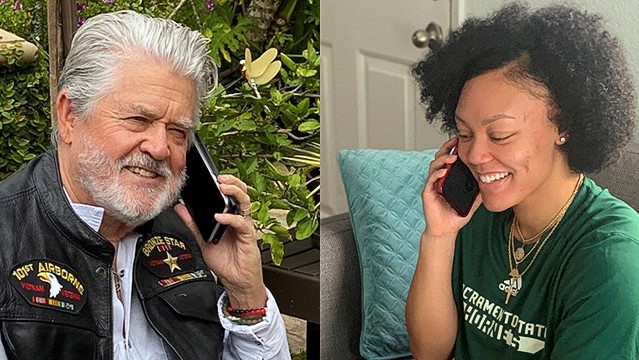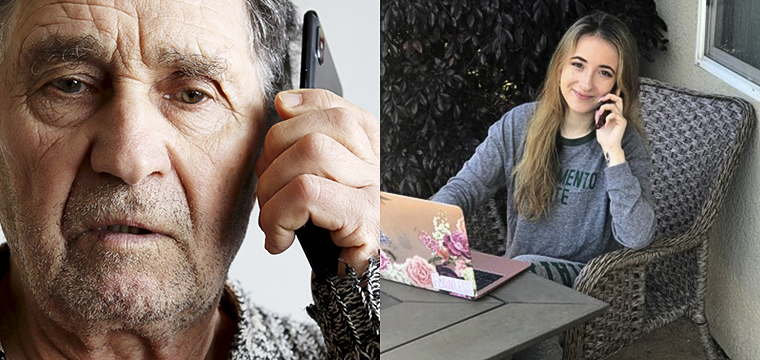
By Cynthia Hubert
One California senior was distressed because she could not visit her husband in his Alzheimer’s care home.
Another worried about running out of food.
Some just wanted to talk about their families, their lives, and their feelings as they sheltered in place to curb the spread of the coronavirus.
As part of a state project to help people who may be isolated during the COVID-19 pandemic, Sacramento State Gerontology students have in recent months been contacting older adults and offering resources, information, or simply a friendly voice.
Participating in the Social Bridging Project has also helped these students sharpen communication skills, allowed them to earn college credits at a time when they cannot work face to face with older adults, and given them a sense of pride and accomplishment.
“Not everyone needs immediate help, but for those who do this is a lifeline. It’s also a win for our students who want to work directly with people, which is a challenge during the pandemic.”
“Sometimes people just want someone to talk to, or to tell their stories,” said Caitlin Groark, a “Bridger” who is on track to earn her bachelor’s degree in Spring 2021. “A lot of what I do is just listen,” then offer help based on underlying concerns.
The Social Bridging Project, led by the state’s Listos California campaign, aims to connect people to resources that address issues including loneliness, food insecurity, housing concerns, health care, and wildfire risk.
Groark and 38 other students from Sac State’s nationally recognized Gerontology program, along with other partners across the state, are making the critical phone calls to seniors.
Those calls have led to more than 43,000 conversations with seniors, about 3,500 referrals to wellness agencies, and the distribution of more than 7,000 disaster readiness guides, according to Listos, which runs emergency preparedness campaigns through the Office of the Governor.
“Not everyone needs immediate help, but for those who do this is a lifeline,” said Donna Jensen, who chairs Sac State’s Department of Gerontology. “It’s also a win for our students who want to work directly with people, which is a challenge during the pandemic.”
Gerontology students typically would interact face to face with seniors in care homes and through social service agencies but have been unable to do so since March, when much of the country began sheltering in place in an effort to avoid spreading the virus.
 Social Bridging Project outreach provides interaction and also increases access to needed services for seniors. (Photo courtesy of Listos California)
Social Bridging Project outreach provides interaction and also increases access to needed services for seniors. (Photo courtesy of Listos California)“I think the pandemic is going to result in a big shift in the way we deliver services to older adults in the future,” said Jensen. “We will be doing a lot more things telephonically, and through video chats.” The Bridging program allows students to practice those skills.
Morgan Kincaid, who is on pace to earn her undergraduate degree from Sac State in Fall 2021, said she enjoys working with older adults and is considering becoming a physician’s assistant with a focus on seniors.
“My grandparents raised me, so gerontology was a perfect fit for me,” she said.
As Bridgers, Kincaid and Groark connect via an automated calling system to people age 60 and older whose names are listed in voter registration rolls. They inquire about their well-being and whether they need basic services. Are they able to get groceries during the pandemic? Do they have transportation to medical appointments? Do they feel lonely or stressed?
“The thing that people seem most concerned about are food needs,” said Kincaid. “They may have groceries in the house, but they are worried about getting groceries down the road.”
Bridgers can connect them to services such as local food banks or Meals on Wheels programs.
They also can help people get in touch with locally based programs for Alzheimer’s patients and their families, mental health counselors, transportation programs, and California Friendship Line, which offers emotional support for seniors facing loneliness and anxiety.
Groark and Kincaid said their phone shifts can be frustrating at times, punctuated by hang-ups and harsh words from seniors who suspect they are being scammed.
“Once they understand that you want to help, they’re usually very responsive,” Groark said.
Participating in the program has allowed Groark to sharpen her “people skills,” she said. “It helps me figure out different ways to connect with people through my voice, words and tone.”
For some, a Bridger may be the only person to whom older residents have spoken in weeks or months, Kincaid pointed out.
“Knowing that people are in need during the pandemic breaks my heart,” she said. “It can be discouraging if you get multiple hang-ups or resistance. But all it takes is one person to make it worth it. If you help one, you’re making a difference.”
For more information about the Social Bridging Project, go to listoscalifornia.org